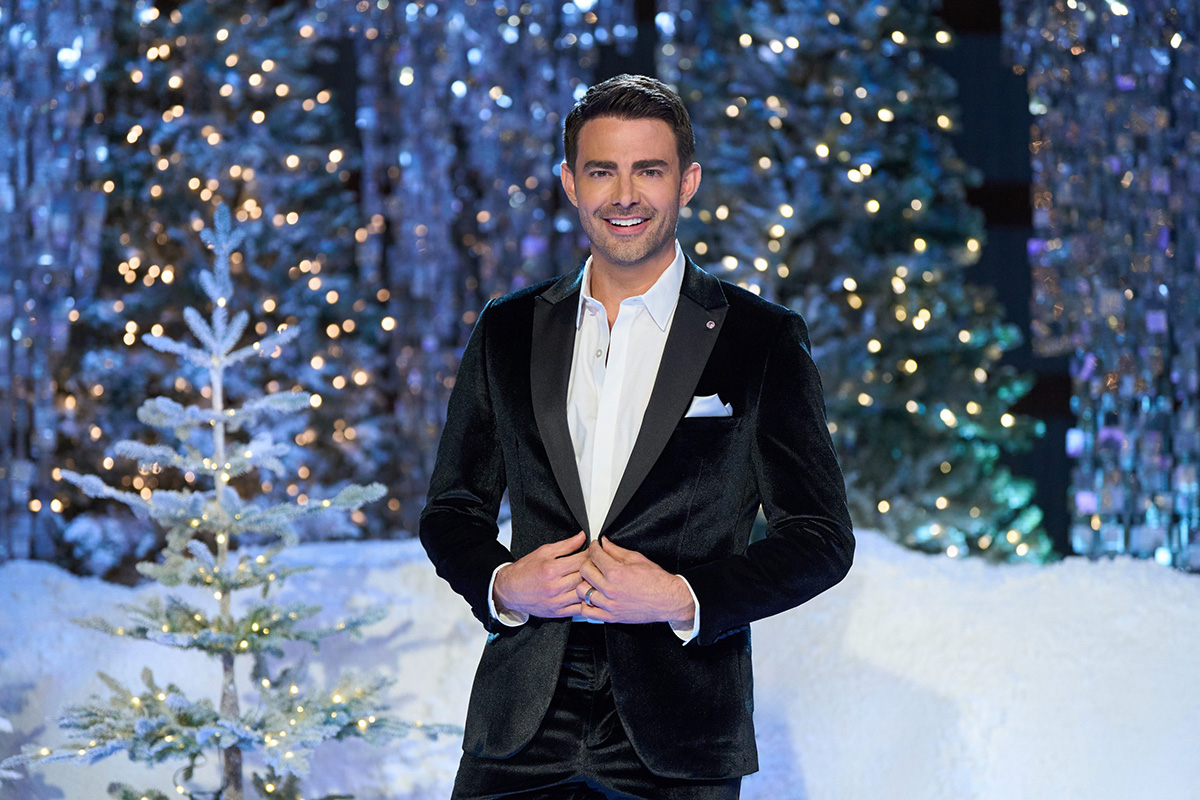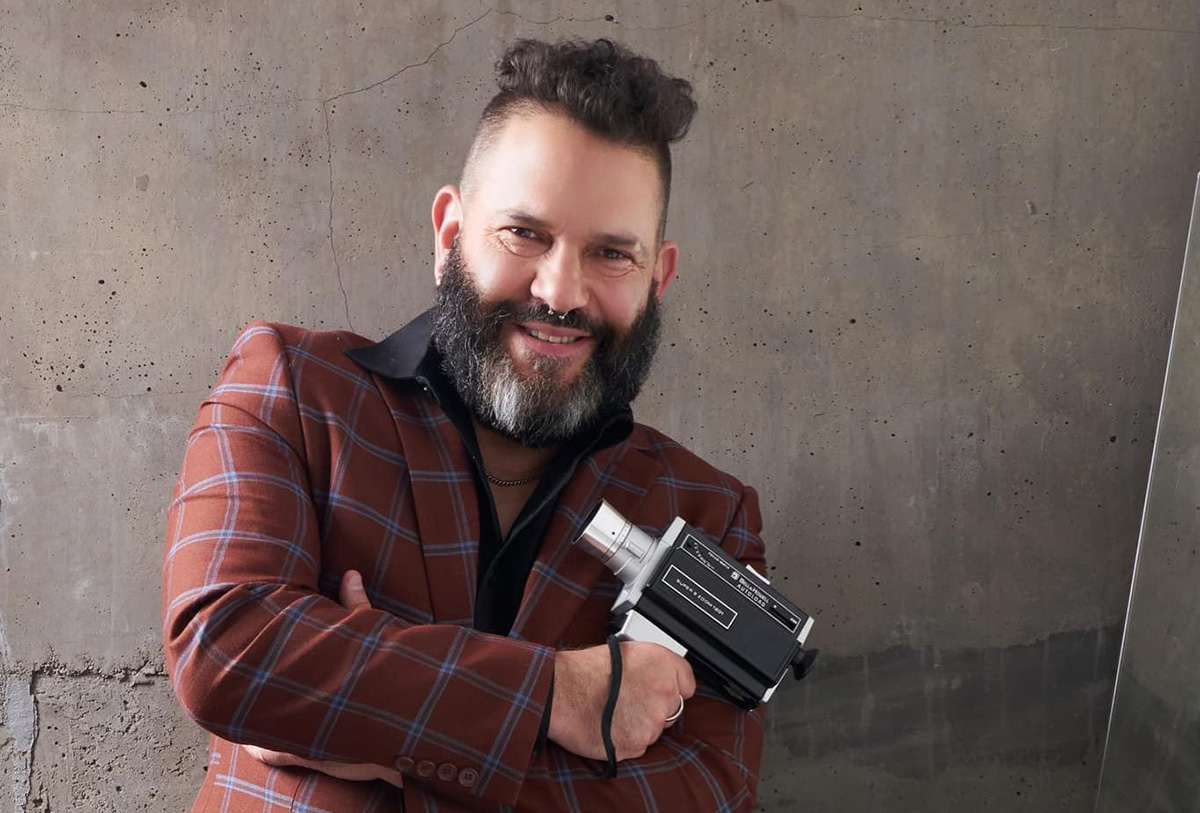a&e features
Diane Rehm successor is not who you’d expect
Out ‘1A’ host Joshua Johnson is passionate journalist first and foremost


Joshua Johnson says launching a new daily two-hour radio show is a ‘mountain of work even under the best of circumstances.’ (Photo courtesy WAMU)
It was last Halloween weekend when Joshua Johnson got the call that he’d been named Diane Rehm’s successor.
Rehm, who began her eponymous National Public Radio call-in show in 1979, retired in December and as of Jan. 2, WAMU broadcasts a new show, “1A” in what had been “The Diane Rehm Show’s” timeslot.
Johnson had subbed for Rehm two days last September and shadowed her another day. Based in San Francisco for the last six-and-a-half years where he was morning news host for KQED while also teaching podcasting at the University of California (Berkeley), Johnson was in Palm Springs visiting friends with Joe Gallagher, his boyfriend of a year and a half, when he got the call. He says it’s a moment he’d been working toward since age 6.
“This wave of peace washed over me and I just got very calm,” says the 36-year-old South Florida native. “It was like my fists finally unclenched after weeks of waiting. I didn’t have that moment of, ‘Oh my God, I’m going to do the show.’ It was just kind of like, ‘Finally — I’ve been waiting on this for my entire life and now it’s going to happen.”
“1A” is a live, two-hour daily WAMU radio program distributed nationally by NPR each weekday at 10 a.m. that seeks to “provide deep conversation about the thorniest issues of our time delivered with insight, intimacy and personality.” It’s both a new, freestanding show but also a successor to the Rehm show, whose “legacy of civil dialogue and analysis” its team hopes to continue.
Producers were initially almost certain they’d hire a woman to succeed Rehm.
“We weren’t 100 percent sure, but you know, sort of in the high 80s or 90s,” says Rupert Allman, “1A’s” executive producer. Johnson won the search team over, Allman says, with his “huge relatability.”
“There was something about his own curiosity and his manner that was really appealing,” he says. “Especially the idea that he was very much interested in civil dialogue, taking time to develop arguments and not always chasing the next shiny ball. Those pieces came together and the stars began to align and that was it.”
Nobody’s universally loved in this era of Internet trolling, but early signs are strong for Johnson. “1A” is being carried on 204 stations with more expected in April (“The Diane Rehm Show” was carried on 198) and WAMU says the show was the No. 1 regional performer in its time slot throughout January, the latest month for which figures were available. WAMU says it expects the show will have a weekly audience of about 2.5 million soon based on early numbers.
Johnson, as loquacious as you’d expect, sat with the Blade in a WAMU conference room on Feb. 16. His comments have been edited for length.
WASHINGTON BLADE: How do you feel it’s going so far?
JOSHUA JOHNSON: It’s going well. Very, very busy. There’s no lack of things to talk about for sure, but it’s good. Launching a national show, any new show, is a heavy lift to say the least, but we have an amazingly good team and we’ve had lots of support from listeners and stations. We’ve found interesting ways to talk about what’s going on in the world and to divert from the headlines that have everyone’s attention to talk about other topics that may be getting lost in the shuffle around the new administration. And we’ve also found ways to take a breath and just do topics that are fun or different as a little relief from the top of the news cycle, so I think it’s been good.
BLADE: What’s your strategy to turn this into more of a Johnny Carson-to-Jay Leno kind of succession as opposed to, say, a Pat Sajak kind-of thing?
JOHNSON: The only thing we can do is control each day’s program and that’s what I try to focus on. I never worry about the 37 years that came before me. That’s Diane’s legacy and that’s solid and done. …. If you worry too much about the distant future, you miss the opportunity to really knock out today.
BLADE: Has the learning curve been about what you thought it would be?
JOHNSON: I tried to come in with very few expectations other than it would be really, really hard and it has been. …. But we’ve gone down from me working like 16-17-hour days to more like 12-13, so that’s a big step forward. … It’s just a mountain of work even under the best of circumstances.
BLADE: What’s been your favorite episode so far?
JOHNSON: I don’t have one. We did a Sunday show a few weeks ago on the immigration ban and we just let stations air it if they wanted to. … But we probably haven’t done my favorite show yet or even conceived of it. I think for me to start grabbing onto favorites at this point would set the bar too low for what we want to be. I don’t think what we’ve done in our first month will compare to what we’ll be doing a year from now or five years from now.
BLADE: When things are crazy, do you get energized or stressed by that?
JOHNSON: Probably a little bit of both. I tend to be the kind of person that the crazier things are around me, the calmer I get, which is how I survived breaking news. … But you have to be on the outer edge of your comfort zone in order to grow, so I just accepted that that was going to be the way it was going to be some days or maybe even most days.
BLADE: Was it hard to leave San Francisco?
JOHNSON: It was really, really hard … but this opportunity was worth it.
BLADE: Have you had any time to explore Washington much yet?
JOHNSON: No. I live a few blocks from the station here in Van Ness, so I walk to work because I cannot take a snow day. And everything I need is right here, the grocery store, the gym and so on. Once I get a better handle on the workload, I’ll be able to get out more and see the city.
BLADE: Were you intimidated to accept?
JOHNSON: Not really. …. I think I was more grateful and humble. … I felt very ready. Like, “Yeah — I’ve been preparing for this for 30-plus years.”
BLADE: You say you had this dream since age 5 or 6. How was this type of thing even on your radar at that age?
JOHNSON: Well, Kermit the Frog played a reporter on “Sesame Street.” …. I grew up seeing Ed Bradley on “60 Minutes” or Bernard Shaw on CNN or Dwight Lauderdale on my local Miami ABC station. Seeing those black men doing what I wanted to do just instantly clicked for me. I always had an affinity for broadcasting. I just didn’t know what form it would take.
BLADE: So was it something you chose or did it choose you?
JOHNSON: Well, it has to be both. Just because destiny knocks doesn’t mean you have to answer. It went through a lot of permutations of whether I would answer or how I would answer and then eventually it became that one thing that I knew if I didn’t go after, I’d regret the rest of my life.
BLADE: Had you been a big listener of “The Diane Rehm Show”?
JOHNSON: Yeah, I listened to her in South Florida on the station where I grew up, WLRN. I never thought I’d be her successor, but yeah, I listened to her for years.
BLADE: How do you decide on the balance between meat-and-potatoes news topics and lighter stuff?
JOHNSON: I don’t think it’s a matter of balancing lightness against substance. The show we did on country music was very substantive. What we’re always trying to figure out is what is it about today’s show that a fan would tell their friends, “You gotta listen to today’s ‘1A.’” Why? How do you answer that? if you start there and work backwards, you can build a great show. So even if it’s a lighter topic like country music today or the Grammy Awards or the Super Bowl, we never want it to feel like, “OK everybody, we know life is really hard so we’re just gonna give you some sugar and candy for an hour.” That’s not good enough. Even if it’s not politics or not some trouble-in-the-world topic, it still has to be time well spent. Plus, I get bored easily, so I get tired of talking about the troubles of the world all day. …. It can’t be all sugar but it can’t be all steak.
BLADE: Some people are saying there’s been more sugar though lately. The Super Bowl show got some flak.
JOHNSON: It depends whose table you’re dining at. I think there are different ways to talk about different things. I did have a listener who got very snooty about the Super Bowl show …. but there are many aspects to a cultural event like that that are worthy of discussion. … Just because people listen to NPR doesn’t mean they don’t watch football and just because they listen to NPR doesn’t mean they don’t like pop music.
BLADE: True, but hasn’t NPR always sort of been that hub where you could get something you couldn’t just get anywhere else? If ESPN is doing round-the-clock sports coverage, do we really need to hear about sports on NPR too?
JOHNSON: But we don’t talk about the Super Bowl like ESPN would talk about it. We didn’t get caught up in stats and who’s up and who’s down. We talked about it more broadly, about what was going on in Houston and sort of the politics around the event, the cost of buying an ad there and so on. We tried to make it really fun. One thing public media serves is to give people a diverse view on the world. Anybody who thinks public media is designed to be all meat and potatoes all the time has clearly never heard “Car Talk” or “Wait Wait … Don’t Tell Me.” … These are just wonderful shows that are about interesting things that make life worthwhile and we can’t pretend that doesn’t matter.
BLADE: Does the “1A” format give you more opportunity to weigh in than other journalism posts you’ve had?
JOHNSON: No. My job is still to be an analyst of the day’s events. This is not the Joshua Johnson show. It’s not my platform to tell you what I think about the news. I’m still a reporter. But that doesn’t mean I can’t call out inconsistencies. The other day we had a guest who kind of fudged an answer on climate change and I (called him out). But I can do it in a way that hews to evidence and fact and not just my belief.
BLADE: There’s so much obfuscation in partisan discussions, though. How do you press people for clarity without sounding partisan, at least at times?
JOHNSON: The way we’ve been doing it —what we do works. You do your homework, you do smart shows, you ask smart questions and you don’t worry about whether people like you or are comfortable with it. I’m here to perform a service as a journalist. … For me to start worrying about it now is to doubt the very reasons I came here. Facts still matter, the truth is still the truth and there are still such things as facts. People know and understand what the NPR standard is and outlets that don’t follow that standard — I don’t need to worry about people who deal in that kind of foolishness.
BLADE: How do you decide if you’re going to pick up a thread after a break or not?
JOHNSON: It depends what’s coming up after the break. If we have a guest we need to get to or we have other questions that segue into that thought. Being in the studio is basically air traffic control because we have guests in the studio, remote guests, my script, my questions, I’m watching the clock, I have a timer that counts down to certain elements, then I have another screen that shows me e-mails and Tweets and Facebook posts and if we receive a voicemail during the show, we can play that. I have my laptop, which has more communication, I’m in touch with the control room and the newsroom upstairs and it’s all happening at once. There are all these different elements that I have to make balance so it’s a lot of plate spinning. It will be different every single day and I have to figure out in the moment what we’re going to next and if it’s duplicative of what we just said, how much time we have left and so on.
BLADE: How many people work on the show and are any of them veterans of Diane’s show?
JOHNSON: I think we have 11. Two of them were former producers on her team. The rest are new hires.
BLADE: Do you anticipate getting more mileage out of the Trump administration than you otherwise would have?
JOHNSON: There’s more to life in Washington so I don’t look to any one sector of the news as my bread and butter. … Also, public radio is very committed to the idea of localism … so we can’t allow the current political climate to eclipse all of that because then you’re basically saying that localism doesn’t matter anymore … so we keep that all in perspective.
BLADE: Even though “1A” is distributed throughout the country, doesn’t it seem slightly odd considering WAMU’s push for live and local to have brought you in from San Francisco? Some listeners were predicting a Washington person. Do you know how many names were in the hat?
JOHNSON: I don’t. I’ve heard different numbers but I honestly don’t know nor do I know who they were. As for live and local, we are live and we are a program from WAMU. I think it’s important to the DNA of public radio that local stations are a provider of national programming (gives examples). We are Washington’s NPR station and we think the ability of WAMU to produce shows like “1A” and “Big Listen” is something we can be proud of. (Allman says Johnson’s outsider status was a plus. “[We liked that] he wasn’t from D.C., is not wowed by the Beltway. He brings a completely different perspective on the country. He gives the audience something new, someone they didn’t know so it doesn’t just seem like the business of shuffling people around.”)
BLADE: You seem at times a bit more abrupt than Diane. Do you agree?
JOHNSON: I try not to be. If I interrupt, I try to apologize for it unless they’re just going off the deep end. I try to be as respectful as I can but that doesn’t mean we have time to let everybody finish their thought.
BLADE: How serious are you and your boyfriend? Any plans for him to move out here eventually as well?
JOHNSON: He owns a barbershop in San Francisco so there are some moving parts we’d have to figure out. For now, we’re doing the bicoastal thing. We’ll make it work.
BLADE: Is Millennial engagement a big push at NPR? Are NPR stations seeing the drop-off we hear about at the orchestra, the ballet, the mainline churches and so on?
JOHNSON: Millennials have gotten a bad rap. They consume immense amounts of news and information — they just do it differently. There are a lot of NPR member stations that are trying to be where younger audiences are. … We’re also getting better at saying, “Hey, maybe we don’t have a relationship now, but check this out.” Or, “We’ll try to make ourselves available in a bunch of different ways and if you only listen once or twice, that’s cool.” Or, “If you’re a fan of this podcast or station but don’t yet understand why you should give, fine.” … We’re getting better at accepting people where they are in the continuum of use in public radio. …. I think the institutions that do well are going to be the ones that skate harder in the direction the puck is going, not just going in the direction they wish it would go.
BLADE: You told Diane Rehm you hoped race would inform the program but not be the lens of the program. What’s the difference?
JOHNSON: Well, it’s about taking the experiences of your life and using them to add context to a conversation. You know, my lens on life is that I’m an African-American man in the 20th and 21st century. I can’t pretend that’s not who I am. So for me to pretend that it’s not or to pretend that I view life with no conception of race, that would be a lie. I have to acknowledge my life experiences. But at the same time as a journalist, I can step out of those experiences and try to view something from another person’s perspective. I can’t step outside of what I won’t acknowledge. It’s like taking off a shirt you don’t admit you put on. I have to own the truth of my life … but I don’t want people to feel like it’s a black man’s perspective on the news or that I’m a black man doing the news. Because I own the totality of who I am, I can step out of it as a journalist and say, “OK, let me see how people with different life experiences than me view this.”
BLADE: Did either being gay or being black pose any career hindrances?
JOHNSON: I don’t think either one was detrimental. I grew up in South Florida, which is a very gay-friendly news market. … I made a decision early on that I couldn’t make a career out of telling the truth about everyone else’s life while lying about my own. I knew eventually one of those lies would come back to bite me because one of them would be leverage for someone to use over me, so I decided I just needed to own the whole truth of my life and not let that be an impediment to my success. … Once you as a gay man deal with shame and you learn how poisonous it is, it can give you the leverage to never impute that shame on other people because it never helps, it never lifts up, it never clarifies, it never improves anything. … It burns everything it touches, so I just decided not to play with that fire because I knew what that burn feels like.
BLADE: That’s profound — what age were you? I wouldn’t have been able to articulate any of that at 16, 17, 18.
JOHNSON: I wouldn’t have been able to say that to you at that age either but I tend to be a very logical person but growing up in the Baptist church … I just thought to myself, the scriptures say you will know the truth and the truth will set you free. Well, this is the truth of my life. There has to be some freedom in here somewhere and I just held on to that. This is what the book says. This has to make sense somehow. That thought process always served me well as a journalist so how do these two things lock together? I just allowed that process to play out.
BLADE: But you make it sound so tidy. Surely there was some angst at some point, no?
JOHNSON: Oh, of course there was. This was just the ending. But yeah, there were times it was awful, it was terrible. Coming out sucks even under the best of circumstances. But working through that gave me a way to figure out where my inner reservoir of toughness came from in terms of career. I knew I had this dream and I was too greedy to give up on it.

Some gifts scream practical, others whisper luxury, and a few flat-out blur the lines. From cocoa that feels ceremonial to a cologne that linger like a suggestive smirk, this year’s ultimate gift picks prove that thoughtful (and occasionally naughty) presents don’t have to be prosaic. Welcome to your holiday cheat sheet for festive tangibles that get noticed, remembered, and maybe even result in a peck of gratitude planted under the mistletoe. Consensually, of course.
Amber Glass Champagne Flutes
Pop the champs – but make it vintage. These tulip-shaped stunners in amber-tinted glass bring all the Gatsby vibes without the Jazz-age drama. Whether you’re toasting a milestone or celebrating a Tuesday, their seven-ounce capacities and hand-wash-only care make ‘em as practical as they are pretty. Pair with a thoughtful bottle of bubs and gift with a glittering wink. $18, NantucketLooms.com
Disaster Playbook by Here Comes the Apocalypse
Because the end of the world shouldn’t be a solo act, this spiral-bound guide is your step-by-step roadmap to surviving and thriving when everything else goes sideways, which might be sooner than you think. Packed with checklists, drills, and a healthy dose of humor, it’s like a survival manual written by your most prepared (and slightly snarky) friend. Whether you’re prepping for a zombie apocalypse or, more realistically, REVOLUTION!, this playbook’s got your back. $40, HereComesTheApocalypse.com

Wickless Vulva Candles
Bold, luxurious, and completely flame-free, CTOAN’s wickless candles melt from beneath on a warmer, releasing subtle, sophisticated fragrances, like sandalwood or lavender. The vulva-shaped wax adds a playful, provocative element to any space –perfect for a bedroom, living room, or anywhere you want elegance with an edge. A gift that celebrates form, intimacy and self-expression, no fire required. $39, CTOANCO.com
Villeroy & Boch Royal Classic Christmas Collection
Every meal is a mini celebration – with whimsy at every place setting – in Villeroy & Boch’s Royal Classic festive dinnerware collection that hits all the right notes. Made from premium German porcelain, it features nostalgic little toys, nutcrackers, and rocking horses in delicate relief, giving your holiday spread a playful but refined twist. Dishwasher- and microwave-safe, it’s luxe without the fuss. Gift a piece to a special someone, or start a collection they’ll use (and show off) for years to come. $22-$363, Villeroy-Boch.com
Greenworks Electric Lawnmower
You a ’hood queen who considers lawn care performance art – or just wants to rule the cul-de-sac in quiet, emission-free glory? Greenworks’ zero-turn electric mower has the muscle of a 24-horsepower gas engine but none of the fumes, drama or maintenance. Six 60V batteries and a 42-inch deck mean you can mow up to two-and-a-half acres on a single charge – then plug in, recharge, and ride again. It’s whisper-quiet, slope-ready, and smooth enough to make you wonder why you ever pushed anything besides your queer agenda. The perfect gift for the homeowner who loves sustainability, symmetry, and showing off their freshly striped yard like that fresh fade you get on Fridays. $5,000, GreenworksTools.com
Molekule Air Purifier
For the friend who treats their space like a sanctuary (or just can’t stand sneezes), the Molekule Air Pro is magic in motion. Covering up to 1,000 square feet, it doesn’t just capture allergens, VOCs, and smoke – it destroys them, leaving your air feeling luxury-clean. FDA-cleared as a Class II medical device, it’s serious science disguised as modern design. Gift it to your city-dwelling, pet-loving, candle-burning friend who likes their living room as pristine as their Instagram feed. $1,015, Molekule.com

Cipriani Prosecco Gift Set
Effervescent with stone-fruit sweetness and a touch of Italian flair, the Cipriani Bellini & Prosecco gift set brings brunch-level glamour to any day of the week. The Bellini blends rich white-peach purée with sparkling wine, while the dry ’secco keeps things crisp and celebratory. Pop a bottle, pour a flute, and suddenly winter weeknights feel like a party – even with your pants off. $36, TotalWine.com
Woo(e)d Cologne
British GQ recently crowned Woo(e)d by ALTAIA the “Best Date Night Fragrance,” and honestly, they nailed it. Confident without being cocky – smoky gaïac and Atlas cedarwood grounds the room while supple leather and spicy cardamom do all the flirting – it’s a scent that lingers like good conversation and soft candlelight. Gift it to the one who always turns heads – or keep it for yourself and let them come to (and then on) you. $255, BeautyHabit.com

Lococo Cocoa Kit
Keep the run-of-the-mill mugs in the cabinet this Christmas and pull out Lococo’s handcrafted Oaxacan versions that demand you slow down and sip like it matters. Paired with a wooden scoop, rechargeable frother, and Lococo’s signature spice hot-chocolate blend (vegan, gluten-free, with adaptogenic mushrooms), this holiday kit turns Mexi-cocoa into a mini ritual you’ll look forward to. Perfect for anyone who loves a little indulgence with a side of ¡A huevo! energy.
Manta Sleep Mask
Total blackout, zero pressure on the eyes, and Bluetooth speakers built right into the straps, this ain’t your mama’s sleep mask — but it could be. The Manta SOUND sleep mask features C-shaped eye cups that block every hint of light while ultra-thin speakers deliver your favorite white noise, meditation, or late-night playlist straight to your ears. With 24-hour battery life, breathable fabric, and easy-to-adjust sound, it turns any bed (or airplane seat) into a five-star sleep suite. Perfect for anyone who treats shut-eye like an art form (or just wants to escape their roommate’s late-night bingin’ and/or bangin’). $159, MantaSleep.com

Shacklelock Necklace
Turn the industrial-chic vibe of a shackle into a sleek statement. Mi Tesoro’s platinum-plated stainless-steel necklace sits on an 18-inch wheat chain, featuring a shackle-style latch pendant that’s waterproof, tarnish-free, and totally fuss-les. Beyond style, it nods to a classic gesture in the queer leather community: replacing a traditional Master lock with something elegant to quietly signal belonging to someone special. Wear it solo for a minimalist edge or layer it like you mean it; either way this piece locks in both your look and your intentions. $90, MiTesoroJewelry.com
Parkside Flask Mojave Edition
Wine nights get a desert glow-up with Parkside’s limited-edition 750-milliliter all-in-one flask draped in sun-washed bronze and badland hues like sage, sand, and terracotta – with magnetic stemless tumblers that snap on for effortless shareability. It keeps your vino chilled for 24 hours, pours without drips (no tears for spilled rosé, please), and even lets you laser-engrave your own mantra or inside joke. Perfect for picnics, surprise rooftop clinks, or gifting to your favorite wine (or desert) rat. $149, HighCampFlasks.com

Mikey Rox is an award-winning journalist and LGBT lifestyle expert whose work has published in more than 100 outlets across the world. Connect with him on Instagram @mikeyroxtravels.
a&e features
Meet Mr. Christmas
Hallmark’s Jonathan Bennett on telling gay love stories for mainstream audiences

Jonathan Bennett believes there are two kinds of people in the world — those who love Hallmark movies and liars. And in Season 2 of Finding Mr. Christmas, which the Mean Girls star co-created with Ben Roy, Bennett is searching for Hallmark’s next leading man.
“It’s so fun for people because everyone in their life has someone they know that they think should be in Hallmark movies, right? The UPS driver, the barista at the coffee shop, the dentist,” Bennett says. “So we’re testing their acting abilities, we’re testing who they are, but we’re also looking for that star quality — the thing that makes them shine above everyone else. It’s almost something you can’t explain, but we know it when we see it.”
Season 2’s cast includes a former NFL player for the Green Bay Packers, a few actors, and a realtor. The 10 men compete in weekly festive-themed acting challenges, one of which included having to ride a horse and act out a scene with Alison Sweeney. The contestants were chosen from a crop of 360 potential men, and Bennett gives kudos to the show’s Emmy-nominated casting director, Lindsay Liles (The Bachelor, Bachelor in Paradise).
“She has a tough job because she has to find 10 guys that are going to be good reality television, but also have the talent to act, carry a scene, and lead a Hallmark movie eventually,” he says. To be the right fit for a Hallmark leading man, Bennett singles out five key characteristics: you have to be funny, charming, kind, have a sense of humor, and you have to do it all with a big heart.
Of course, Finding Mr. Christmas wouldn’t be Finding Mr. Christmas without its signature eye candy — something Bennett describes as “part of the job” for the contestants. “I can’t believe Hallmark let me get away with this. I dressed them as sexy reindeer and put them in harnesses attached to a cable 30 feet in the air, and they had to do a sexy reindeer photo shoot challenge,” he says with a laugh. “This season is just bigger and bolder than last. People are responding to not only all the craziness that we put them through, but also comparing and contrasting the guys in their acting scenes when we do them back-to-back.”
Season 1 winner Ezra Moreland’s career has been an early testament to the show’s success at finding rising talent. On seeing the show’s first winner flourish, Bennett says, “Now to watch him out in the world, just booking commercial after commercial and shining as an actor and a model, I think the show gave him the wings to do that. He learned so much about himself, and he took all that into his future auditions and casting. He just works nonstop. I’ve never seen an actor book more commercials and modeling gigs in my life.”
Bennett has been a star of plenty of Hallmark movies himself, including the GLAAD-award-winning The Groomsmen: Second Chances, which makes him a fitting host. Among those movies are 2020’s Christmas House, which featured the first same-sex kiss on the network and had a major impact on Bennett’s career as an openly gay man. “Hallmark’s been so great about supporting me in queer storytelling. But again, I don’t make gay movies for gay audiences. I make gay love stories for a broad audience, and that’s a huge difference, right? We’re not telling stories inside baseball that only the gay community will understand.”
He continues, “The backdrop of a Hallmark Christmas movie is very familiar to these people who watch. And so when you tell a gay love story, and you tell it no differently than a straight love story in that space, they’re able to understand. It’s able to change hearts and minds for people who might not have it in their lives.”
While Hallmark has become a major staple of Bennett’s career, he started off wanting to be a Broadway actor. And before the first season of Finding Mr. Christmas aired, Bennett took a break from TV to make his Broadway debut in Spamalot, replacing Michael Urie as Sir Robin and starring alongside Ethan Slater and Alex Brightman.
“That was my dream since I was five years old – then I booked a movie called Mean Girls, and everything kind of changes in your life. You no longer become a person pursuing Broadway, you become a part of pop culture,” Bennett recalls. “And to be honest, when I hit 40, I was like, ‘I’m probably never going to get to live that dream.’ And that’s okay, because I got to do other dreams and other things that were just as cool but different. So I honestly never thought it would happen.”
Bennett is still determined to make his way back on Broadway with the right role — he calls Spamalot the “best experience” of his life, after all — but he’s got another Hallmark show lined up with Murder Mystery House, which he co-created. The show was recently greenlit for development and intends to bring the Hallmark mystery movie to life. “It’s kind of like our version of The Traitors,” Bennett admits.
Looking back on both seasons, Bennett says that what makes Finding Mr. Christmas stand out in the overcrowded reality TV landscape is that everyone involved makes it with heart: “This isn’t a show where you’re going to watch people throw drinks in each other’s faces and get into big fights. The thing that has amazed me so much about this show, the more we’ve done it, is that every season, 10 guys come in as competitors, but they leave as a family and as brothers. That’s something you don’t get on any other network.”
Finding Mr. Christmas airs every Monday on Hallmark through December 20, with episodes available to stream on Hallmark+.
a&e features
Guillermo Diaz on his role as a queer, Latino actor in Hollywood
Shattering stereotypes and norms with long resume of roles

Actor Guillermo Diaz has been working hard in the entertainment industry for more than three decades. Proud of his heritage and queer identity, he has broken through many glass ceilings to have a prolific career that includes tentpole moments such as roles in the films Party Girl, Half Baked, and Bros, and in major TV shows like Weeds and Scandal, and even in a Britney Spears music video. This season, he made his feature-length directorial debut with the film Dear Luke, Love Me.
In an intimate sit-down with the Blade, Diaz shares that he attributes a lot of his success to his Cuban upbringing.
“Well, it prepared me to learn how to lie really well and be a good actor because it was a lot of acting like you were straight, back in the eighties and nineties (laugh). Another thing I learned from my Cuban immigrant parents is that they work super hard. They both had two jobs; we were latchkey kids, and I just saw them constantly working and wanting to provide for us by any means. So that was super instilled in me. That was the one thing that really stuck out that I admire and respect.”
Besides Diaz’s recurring roles on TV, his resume includes appearances in just about every genre of programming out there. If there is a major show out there, he was probably on it. Law and Order, Girls, The Closer, Chappelle’s Show, ER, Party of Five, and the list goes on. He’s accomplished more in his career thus far than most actors do in a lifetime. There is no doubt he is a hard worker.
“It’s a sign that I just loved to work, and it’s funny looking back at it now because you see all those things, but at the time it was just the next gig, the next job. I was just wanting to keep working and acting and learning and doing all that stuff. Then it sort of accumulates, and you look back and you’re like, damn! That’s a lot of stuff!”
Acting was never on Diaz’s radar until he was asked to fill in for a friend in a Beastie Boys medley for a talent show when he was a sophomore in high school.
“I did it and fell in love with it. I was teased a lot in high school. Then, when I did that performance, all those people who teased me were like, you were so great! So I looked at it initially as a thing of like, oh, this is where I’m accepted and people like me when I’m on stage. It’s kind of sad, too, because that’s what I latched onto. And then of course, I fell in love with the craft and performing and acting, but that initial rush was because all these people who were messing with me and teasing me all of a sudden liked me. And I was like, this is what I have to do.”
Little did Diaz know that he would break the mold when it came to stereotypical casting. When he first hit the industry, diversity and positive representation were not a thing in Hollywood.
“You just kind of accepted at the time. It was the early nineties. 90% of the time, it was playing a thug or a gun dealer, or a crack head – it was all bad guys, negative characters. But it was either that or not act and not be in anything. So you just kind of accept it, and then you have this sort of vision or hope that in the future it’s going to get better.
Diaz’s management was trepidatious about him playing gay roles for fear of being typecast. But Diaz did play a handful of gay roles early on, although he passed on But I’m A Cheerleader, which went on to become a gay cult classic. Diaz decided early on that he was not going to hide his sexuality. Diaz appeared in the film Stonewall. That was the defining point for him in sharing his identity.
“Being cast in that historical sort of dramatization of the 1969 Stonewall riots – I couldn’t believe I was in the midst that I was in the middle of doing this and playing the lead drag queen on the film. I just felt so honored, and I knew it was important, and I knew I needed to do a really good job. I thought, what a special moment this is. And it kicked my ass shooting that movie.
I remember after doing Stonewall, people saying, well, now you’re either going to have to make a choice if you’re going to lie, or if you’re going to just be honest, and you’re going to have to be out from now on if you’re going to be honest. And I was like, I’m not going to freaking lie. When they’d asked me, I would say I was gay. I think because I never tried to hide it, it didn’t become a thing. So people just kind of ignored it. It didn’t mess with me or my career. I don’t know. Or I just got lucky. I don’t freaking know.”
As a queer, Latin actor, Diaz is all too aware of what is happening politically and socially in the world towards minority communities. Does he think actors have a place in politics?
“For sure. I mean, we’re people first, right? Like, I hate when people sort of are like, oh, you’re an actor, shut up. I’m super political and outspoken, and I’m that guy who will say shit. I’m on the right side of history, at least. I’m not being complicit and silent. So, yeah, I think actors for sure have a place in politics. Absolutely.”
While directing was on Diaz’s radar, it wasn’t something that he was actively searching out. But as life would have it, his friend Mallie McCown sent him her script for Dear Luke, Love Me, a film she would play the lead in. Diaz was hooked.
“It was one of those scripts that I had to keep putting down every like 20 pages. I would put it down because I didn’t want it to end. It was so good. Originally, I was just going to come on as a producer of the film, and then the director dropped out, and then Mallie asked me if I was interested in directing. I was scared as shit. I had never directed a feature film. But I was like, it’s now or never.”
The film covers a decade of the friendship between Penny and Luke, covering themes of platonic love, asexuality, co-dependence, and self-identity. With most of the film focusing on just the two leads, Diaz has crafted an intimate and raw film. What is his message with the film?
“That love is complicated, but it’s beautiful and rewarding and worth all the heartache. I believe that. I don’t want to give away too much in the film either, but I think everyone can relate to it because there’s heartache and there’s pain, and there’s beauty and there’s love.”
And in looking at his past work and in looking toward his future career, what kind of legacy does Diaz want to build?
“That I broke some ground, that I knocked down some walls as an artist; I’m hoping that made a difference. It’s funny because when you’re in it, you’re not thinking about all this stuff that could possibly pave the way for other people. You’re just kind of moving along and living your life. But yeah, I would hope that I broke down some walls as a queer Latino.
I hope that people can sort of get something out of me trying to live as authentically as I can, just being my queer self. Hopefully, that helps someone along who is having some troubles being accepted or being comfortable with who they are.”
-

 The White House5 days ago
The White House5 days ago‘Lavender Scare 2.0’: inside the White House’s campaign against LGBTQ federal employees
-

 District of Columbia5 days ago
District of Columbia5 days agoActivists praise Mayor Bowser’s impact on city, LGBTQ community
-

 a&e features4 days ago
a&e features4 days agoMeet Mr. Christmas
-

 Puerto Rico4 days ago
Puerto Rico4 days agoPuerto Rico’s largest LGBTQ organization struggling amid federal funding cuts


















